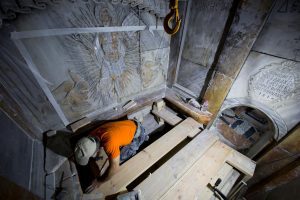“We saw where Jesus Christ was laid down,” Father Isidoros Fakitsas, the superior of the Greek Orthodox Patriarchate, told me. “Before, nobody has.” Or at least nobody alive today. “We have the history, the tradition. Now we saw with our own eyes the actual burial place of Jesus Christ.”
For only 60 short hours, the crew collect samples, took photographs and reinforced the tomb’s structure before resealing it, perhaps for centuries to come. In the end, just about 50 or so priests, monks, scientists and workers had peered inside, and they seem likely to be the only ones on the planet who will do so in our lifetimes.
The tomb was opened as part of a large renovation of the shrine that was build around it long after his death, in now what is known as the Church of the Holy Sepulcher. This is one of Christianities holiest sites and scholars hop to study what they found to determine more about the events leading up to his death.
The church was first built where the tomb was discovered in the fourth century during the reign of Constantine, the first Roman emperor to officially convert to Christianity. It was sacked after Jerusalem fell to the Persians in the seventh century, then rebuilt and later destroyed by Muslim caliphs in the 11th century. After the Crusaders captured Jerusalem, the church was restored in the 12th century but burned to the ground in the 19th century and then rebuilt yet again.
The marble shrine, known as the Aedicule, was built in its existing form in 1810 during the Ottoman era and has been crumbling lately. But only after pressure from the Israelis did the three religious communities that share the church, Greek Orthodox, Armenian Orthodox and Roman Catholic, agree to a renovation that began last spring. Chosen to handle the project was the National Technical University of Athens, which had worked on restorations of the Acropolis in Athens and the Hagia Sophia mosque turned museum in Istanbul.
The conservation experts removed the iron cage built by the British in 1947 to shore up the earthquake-damaged Aedicule and then began taking apart the shrine piece by piece. They removed disintegrating mortar, reconstructed parts of the sometimes-swollen masonry, reset the columns and injected grout into cracks in the structure.
Rainwater had deteriorated much of the mortar over the centuries. Iron support bars that were fully corroded will be removed and replaced by titanium. The specialists had no plans at first to open the tomb, but they decided a couple of weeks ago that they needed to do so in order to ensure that nothing could leak inside.
 It was a delicate operation. The top of the tomb was split, and the specialists worried that lifting it would break it.
It was a delicate operation. The top of the tomb was split, and the specialists worried that lifting it would break it.
“The main goal was not to break the plate,” said Harris Mouzakis, an assistant professor of civil engineering at National Technical University who is working on the project.
The team felt the pressure. “We had to be very careful,” Mr. Mouzakis said. “It was not just a tomb we had to open. It was the tomb of Jesus Christ that is a symbol for all of Christianity — and not only for them but for other religions.”
Once they removed the marble cladding, they discovered another marble slab with a cross carved into it. Beneath that, they found the limestone slab hewed from the wall of a cave that is believed to be where Jesus lay after his death.
That slab had not been seen since at least the 1500s. The team worked around the clock for three days, gathering dirt and other material from inside the tomb for future study. They closed it again quickly to avoid disrupting the visits of pilgrims who still flock to the church each day.
At the same time, clergymen approached the shrine and shook incense; most of the daily church rituals continued as usual while the restoration work went on.
Overall, the renovations were a huge success.
“It will last many, many years,” Mr. Mouzakis said. “We will succeed if after 200 or 500 years somebody will come back to restore our work.”



